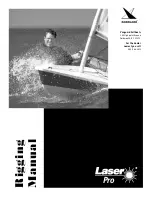
•
Look for exhaust leaking from the exhaust system components
evidenced by rust and/or black streaking, water leaks, or cor-
roded or cracked fittings.
•
Inspect rubber exhaust hoses for burned or cracked sections. All
rubber hoses should be pliable and free of kinks.
•
Confirm that water flows from the exhaust outlet when the
engines and generator are started.
•
Listen for any change in exhaust sound which could indicate a
failure of an exhaust component.
•
Test the operation of each carbon monoxide detector by press-
ing the test button.
Note: Do not operate the vessel if any of these problems exist.
At Least Annually
(performed by a qualified marine technician)
•
Replace exhaust hoses if any evidence of cracking, charring or
deterioration is found.
•
Replace each water pump impeller and inspect the condition of
the water pump housing. Replace if worn.
(Refer to the engine
and generator manuals for further information.)
•
Inspect each of the metallic exhaust components for cracking,
rusting, leaking or looseness. Pay particular attention to the
cylinder head, exhaust manifold, water injections elbow, and the
threaded adapter nipple between the manifold and the elbow.
•
Clean, inspect and confirm the proper operation of the generator
cooling water anti-siphon valve
(if equipped)
.
Fuel System
Everyone who owns or operates a boat must practice fire safety.
Each year, boat fires and explosions injure hundreds of individuals
and cause millions of dollars in property damage. Many of these
accidents can be prevented.
Be alert for damage to your boat’s fuel system. Over time, fuel fit-
tings and fuel hoses wear out. Inspect these fittings and hoses
regularly, especially near the engine where engine heat and vibra-
tion can accelerate deterioration.
What to do
1. Schedule regular engine and exhaust system maintenance
inspections by experienced and trained technicians.
2. Inspect fuel systems annually, particularly hoses, connections
and tank surfaces. Use only USCG-approved fuel hoses.
3. Before fueling, shut down engines and auxiliary equipment and all
electrical equipment. Also close all hatches and doors on board.
4. Do not allow equipment or gear to contact fuel-system compo-
nents. Monitor side storage areas where fill and vent hoses are
often located.
5. Do not store portable fuel tanks in enclosed areas, including the
engine room compartment (even though it may be “ventilated”).
2-11
WARNING
AVOID DAMAGE TO YOUR FUEL SYSTEM
DO NOT USE FUEL OR ADDITIVES CONTAINING MORE
THAN 10% ALCOHOL BY VOLUME (Methanol or Ethanol)
DAMAGE AND LOSS OF WARRANTY MAY RESULT
Содержание 2012 Signature
Страница 16: ...1 7...
Страница 17: ......
Страница 125: ......
Страница 133: ......
Страница 140: ...WIRING SCHEMATICS 12 12 1 Signature 370 Bilge D C Distribution Harness...
Страница 141: ...12 2 Signature 370 Helm Circuit Breaker Panel...
Страница 142: ...12 3 Signature 350 Bilge D C Distribution Harness...
Страница 143: ...12 4 Signature 350 Helm Circuit Breaker Panel...
Страница 144: ...12 5 Signature 330 Fwd D C Distribution Harness...
Страница 145: ...12 6 Signature 330 Helm Circuit Breaker Panel...
Страница 146: ...12 7 Signature 310 Aft D C Bilge Distribution Harness...
Страница 147: ...12 8 Signature 310 Helm Circuit Breaker Panel...
Страница 148: ...12 9 Signature 290 Bilge D C Distribution Harness...
Страница 149: ...12 10 Signature 290 Helm Circuit Breaker Panel...
Страница 150: ...12 11 Signature 270 Bilge D C Distribution Harness...
Страница 151: ...12 12 Signature 270 Helm Circuit Breaker Panel...
















































